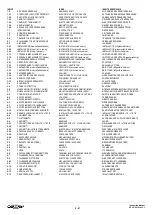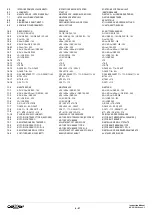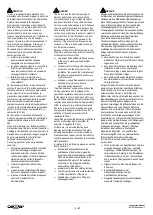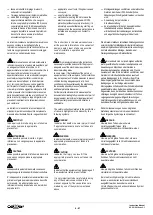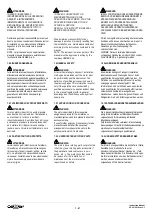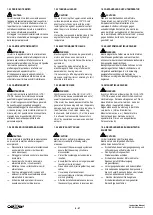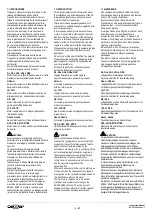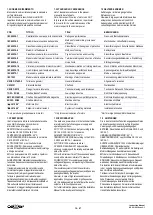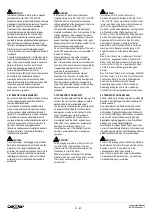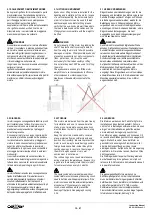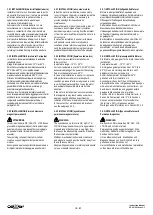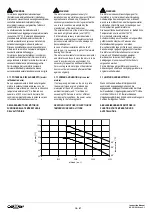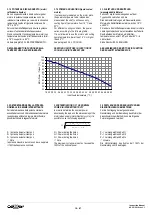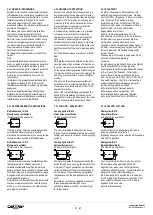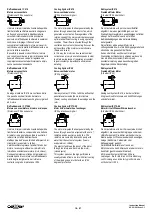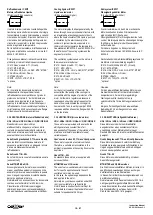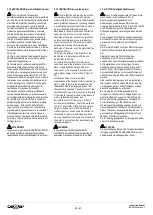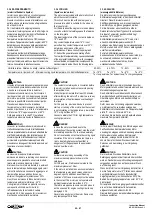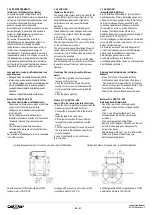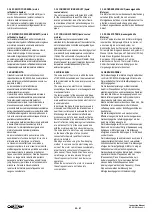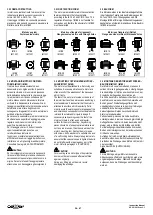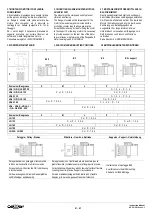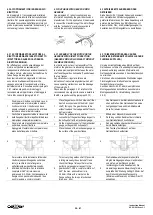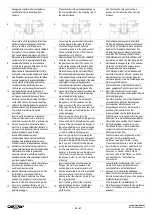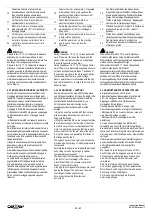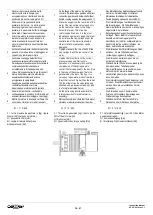
17 - 97
Instruction Manual
AC 02/2019-rev.1.1
3.2.1 GRADO DI PROTEZIONE
Esistono motori costruiti con particolari sistemi di
raffreddamento (es. ventilazione canalizzata) che
pur mantenendo rispetto all’ambiente in
cui sono
installati un grado di protezione IP 23 sono di
fatto riconducibili ai motori IP 54 poiché la
presenza del flusso d’aria impedisce l’ingresso di
polvere o piccoli oggetti.
Allo stesso modo sono disponibili esecuzioni
speciali (es. sovrapressione interna) che
consentono di incrementare il grado di protezione
dei motori chiusi consentendone l’utilizzo anche
in condizioni ambientali paticolarmente severe
con elevati gradi di contaminazione dell’aria
dovuti a presenza di polveri molto sottili o
nebulizzazioni di acqua ed olio.
Per maggiori dettagli consultare il nostro ufficio
tecnico.
Note:
Normalmente gli accessori installati sul motore
hanno un grado di protezione uguale o superiore
a quello del motore stesso. Esistono tuttavia
alcuni accessori che per loro natura non possono
garantire lo stesso grado di protezione del
motore (es. alcuni ventilatori, freni, sonde di
ventilazione).
I motori descritti in questo manuale, anche se scelti
con grado di protezione IP 55 o IP 56, non sono
idonei per essere installati in ambienti con pericolo di
esplosione.
Per avere maggiori dettagli riguardanti il grado di
protezione dei motori, le definizioni delle sigle e le
condizioni ambientali di installazione, consultare le
tabelle tecniche e le norme IEC 60034-5.
3.2.1 DEGREE OF PROTECTION
Some motors with special cooling systems (e.g.
ducted ventilation) have a degree of protection
with respect to the environment they are installed
in equal to IP 23 but provide a similar degree of
protection to IP 54 motors because the airflow
present during motor operation stops small
bodies from getting into the motor.
In the same way, special systems (e.g. internal
overpressure) are available to increase the
degree of protection on closed motors so they
can be used in particularly harsh operating
ambient conditions where is present a high level
of contamination in the air due to the presence of
significant quantity of fine dust or atomized water
or oil.
For further details, please consult our Technical
Dept.
Note:
Normally the accessories installed on the motor
have the same or higher degree of protection as
the motor. However, some accessories installed
on the motors cannot guarantee the same degree
of protection as the motor due to the nature of the
same (e.g. some ventilators, brakes, ventilation
probes).
The motors in this manual are not suitable for
installation in environments where there is a risk
of explosion, even those with an IP 55 or IP 56
degree of protection.
Consult the technical tables and standards IEC
60034-5 for more detailed information on the
degrees of protection, the meanings of the codes
and the environmental installation conditions.
3.2.1 SCHUTZART
Es gibt mit besonderen Kühlsystemen (z.B.
Kanallüftung) ausgerüstete Motoren, die zwar
hinsichtlich der Umgebung, in der sie installiert
sind, Schutzart IP 23 haben, die aber
tatsächlich als Motor mit Schutzart IP 54 zu
betrachten sind, da der vorhandene Luftstrom
das Eintreten von Staub oder kleinen
Gegenständen verhindert.
Ebenso sind Sonderausführungen (z.B.
Innenüberdruck) erhältlich, die eine Erhöhung
der Schutzart von geschlossenen Motoren
ermöglichen, sodass diese auch unter
besonders harten Umgebungsbedingungen mit
erhöhter Luftverunreinigung aufgrund von sehr
feinem Staub oder Wassernebel eingesetzt
werden können.
Wenden Sie sich für nähere Angaben bitte an
unsere Konstruktionsabteilung.
Hinweise:
Es gibt jedoch einige Zubehörteile, die aufgrund
ihrer Beschaffenheit nicht den gleichen
Schutzgrad wie der Motor gewährleisten können
(z.B. einige Lüfter, Bremsen, Lüfterfühler).
Die in diesem Katalog enthaltenen Motoren
sind, auch wenn sie mit Schutzart IP 55 oder IP
56 gewählt werden, nicht für die Installation in
explosionsgefährdeter Umgebung geeignet.
Für nähere Angaben hinsichtlich
Motorenschutzart, Erläuterungen der
Abkürzungen sowie Umgebungs- und
Installationsbedingungen siehe Tabellen
technische Daten und Norm IEC 60034-5.
3.3.1 RAFFREDDAMENTO, VENTILAZIONE
3.3.1 COOLING , VENTILATION
3.3.1 KÜHLUNG, LÜFTUNG
Raffreddamento IC 410
Motore senza ventilazione
(Protezione IP 54 o superiore)
Il motore dissipa il calore derivante dalle perdite
unicamente attraverso la propria struttura
meccanica (carcassa alettata), non sono previste
ventole o sistemi ausiliari di raffreddamento.
Cooling System IC 410
Motor without ventilation
(IP 54 protection or higher)
The motor dissipates the heat from the losses
through its own mechanical structure only (finned
casing), and there are no fans or auxiliary cooling
systems.
Kühlsystem IC 410
Unbelüfteter Motor
(Schutzart IP 54 oder höher)
Der Motor führt die Verlustwärme einzig über
seine mechanische Konstruktion
(Rippengehäuse) ab. Lüfter oder Kühlhilfssysteme
sind nicht vorgesehen.
Raffreddamento IC 411
Motore auto ventilato
(Protezione IP 54 o superiore)
Il motore dissipa il calore derivante dalle perdite
tramite la ventola di raffreddamento che è
calettata direttamente sull’albero del motore e
genera un flusso d’aria variabile in funzione della
velocità di rotazione. Conseguentemente il range
di regolazione di velocità consentito dipende dal
carico applicato al motore.
Normalmente non è consentito un funzionamento
continuo a coppia costante con velocità inferiori
ai 500 rpm circa. Consultare il ns. ufficio tecnico
per maggiori chiarimenti.
Cooling System IC 411
Self-ventilated motor
(IP 54 protection or higher)
The motor dissipates the heat generated by the
losses through its own cooling fan keyed onto the
motor shaft. This fan generates an air flow that
varies on the basis of the motor rotation speed.
For this reason the permitted speed regulation
range depends on the load applied to the motor
shaft.
Normally, any continuous operation at constant
torque under approximately 500 rpm is
unsuitable. Please consult our Technical Dept.
for further details.
Kühlsystem IC 411
Eigenbelüfteter Motor
(Schutzart IP 54 oder höher)
Die Verlustwärme wird durch einen direkt auf
die Antriebswelle gepressten Kühllüfter
abgeführt, der einen je nach Motordrehzahl
variablen Luftstrom erzeugt. Die Lüfterdrehzahl
hängt also von der Motorbelastung ab.
Ein Dauerbetrieb mit konstantem Drehmoment
ist in der Regel bei Drehzahlen unter 500 U/min
nicht zulässig. Wenden Sie sich für nähere
Angaben bitte an unsere
Konstruktionsabteilung.

